Jupiter Joins the Sun and the Morning Moon Posing with Planets Gives Us Galaxy-gazing!
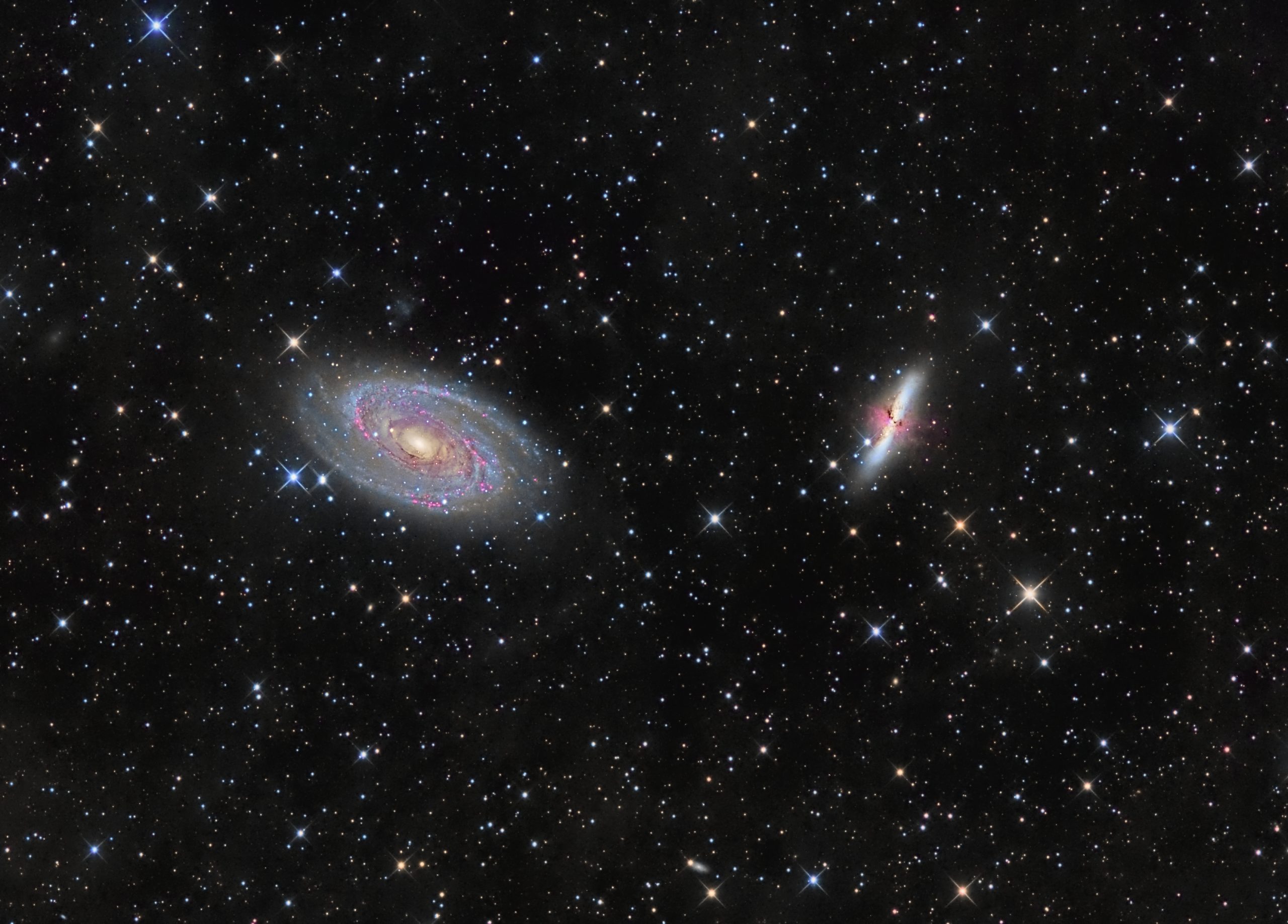
The prominent galaxies Messier 81 or Bode’s Nebula (left) and Messier 82 or the Cigar Galaxy (right) are located near the Big Dipper’s bowl in the northern sky. This image by AstroDoc Ron Brecher of Guelph, Ontario from February, 2017 spans about 1.5 degrees, or three full moon diameters. Messier 81 is large and bright enough to see through a good-sized telescope in suburban skies. Messier 82’s burst of central material makes it a peculiar-type galaxy. Ron’s images are hosted at www.astrodoc.ca
Hello, Spring Stargazers!
Here are your Astronomy Skylights for the week of April 28th, 2024 by Chris Vaughan. Feel free to pass this along to your friends and send me your comments, questions, and suggested topics. You can also follow me on Twitter as @astrogeoguy! Unless otherwise noted, all times are expressed in Eastern Time. To subscribe to these emails please click this MailChimp link.
If you’d like me to bring my Digital Starlab portable inflatable planetarium to your school or other daytime or evening event in Simcoe, Grey, and Bruce Counties, or deliver a virtual session anywhere, contact me through AstroGeo.ca, and we’ll tour the Universe, or the Earth’s interior, together! My book with John A. Read entitled 110 Things to See With a Telescope is a guide to viewing the deep sky objects in the Messier List – for both beginners and seasoned astronomers. DM me to order a signed copy!
The moon will spend this week waning in phase and posing in the morning sky with (and passing in front of) many of the planets gathered there – including Saturn, Mars, and Neptune. The resulting moonless evenings will be ideal for finding and viewing springtime galaxies, so I share lots of tips for galaxy-gazing. The mid-point of spring arrives on Saturday. Read on for your Skylights!
May Day
Saturday evening, May 4 in the Americas is May Day! That date is one of the four so-called astronomical cross-quarter days, which are the midpoints between the solstices and equinoxes. May 4 falls exactly midway between the vernal equinox and the summer solstice – so we can expect the weather to start being less spring-like and more summer-like soon.
You can’t merely divide our 365.25-day year into four 91.3-day-long seasons and then count half that many days to reach the cross-quarters. Planets with elliptical orbits move faster when they are closer to the sun and slower when they are farther away. Since Earth is moving slower at aphelion in July, summers in the Northern Hemisphere are about five days longer than winters, which are a couple of days shorter than the average season-length.
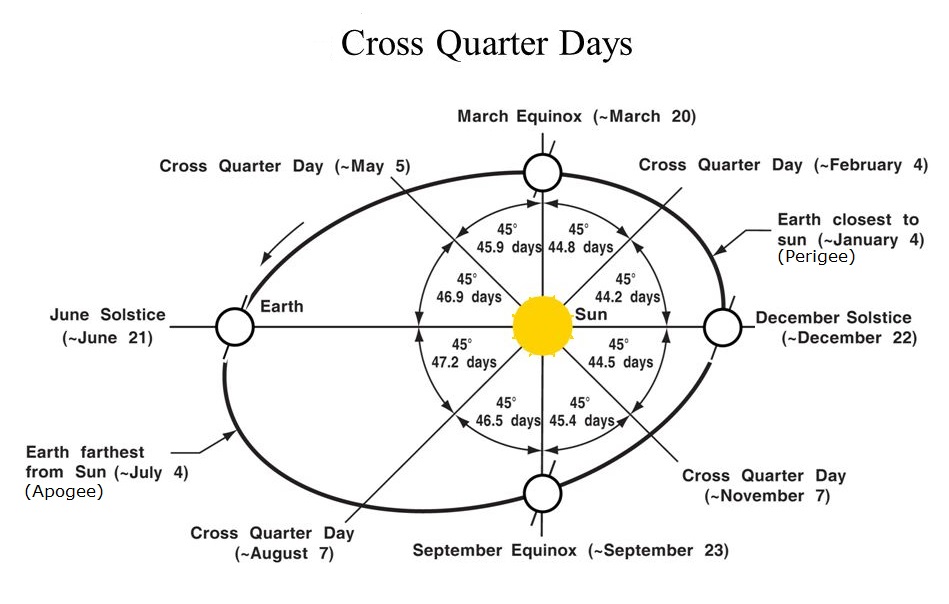
May Day celebrations focus on romantic love, fertility in nature, and the arrival of spring flowers. In contemporary paganism, the day is called Beltane. An old Irish tradition for it involved “Lucky Fire” leaping! In roman times the Maiouma festival honoured Dionysus and Aphrodite. The well-known Cinco de Mayo celebration is a yearly celebration held on May 5 to celebrate Mexico’s victory over the Second French Empire at the Battle of Puebla in 1862 led by General Ignacio Zaragoza. It has no astronomical connection.
The other three cross-quarter days are Groundhog Day (Imbolc) on February 2, Lughnasath or Lammas on August 1, and Samhain on November 1. I think you can guess which spooky “holiday” that last one connects to. In most of those cases, the “holiday” is observed several days before the astronomical cross-quarter. For residents of the Southern Hemisphere, where the seasons are swapped from the Northern Hemisphere, the festivals are offset by six months.
The Moon
The moon won’t be rising until well after midnight this week – allowing stargazers worldwide to view spring galaxies and star clusters! More on that below.
When the still quite bright, waning gibbous moon clears the treetops in the east after midnight tonight (Sunday), it will be encircled by the stars that form the Teapot-shaped asterism of Sagittarius (the Archer). Early risers on Monday can look for the pale moon in the lower part of the southern sky, like the ghost of night. The moon will rise about 50 minutes later each day, wane in illuminated phase, and linger longer into the morning daylight.
The moon will slip into eastern Sagittarius on Tuesday morning and then swim through Capricornus (the Sea-Goat) on Wednesday and Thursday. The moon will officially reach its third quarter phase on Wednesday at 11:27 Greenwich Mean Time, which converts to 7:27 am EDT or 4:27 am PDT. At third, or last, quarter, the moon’s western half is illuminated by the pre-dawn sun and the pole-to-pole terminator line dividing its lit and dark hemisphere becomes a straight line. Just as waxing first quarter moons, available to enjoy after dinnertime, look wonderful under magnification, waning third quarter moons warrant a look before your morning coffee! Familiar features will all be lit from the opposite side.
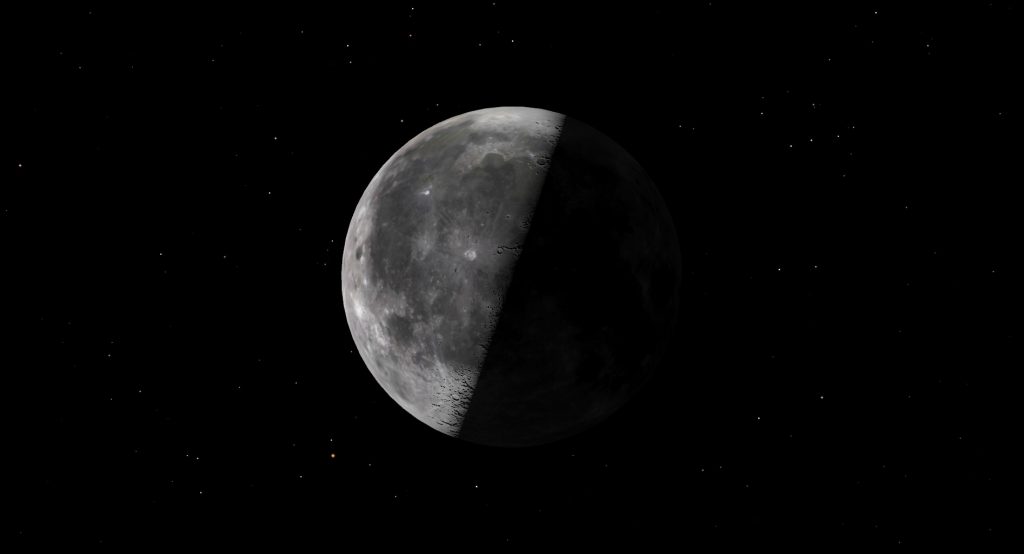
If you head outside around 5 am on Friday, May 3, you can look above the eastern horizon to see the pretty, waning crescent moon shining a palm’s width to the right (or about 8 degrees to the celestial southwest) of Saturn’s bright, yellowish dot. Both of them will shine within the borders of Aquarius (the Water-Bearer). Reddish Mars will be positioned about 1.5 fist diameters to Saturn’s lower left. Far fainter Neptune will be positioned between them near Mars. Binoculars might reveal its blue speck. Half a day later, skywatchers across most of Antarctica, southeastern Australasia, southwestern Polynesia, and southeastern Melanesia can watch the moon occult, or pass very close to, Saturn. The moon will pass in front of planets several times this month.
The moon’s cruise past the morning planets will continue on Saturday morning. After 24 hours, the moon will shine midway between creamy-yellow Saturn and reddish Mars. Neptune will be located between Mars and the moon. The strongly slanted morning ecliptic will keep them all rather low in the sky. Observers located closer to the tropics, where the ecliptic will be more vertical, will see these gatherings more easily. Early on Sunday morning, May 5, skywatchers from southeastern Australia to New Zealand can use a telescope to see the moon occult Neptune.
Another day of travel will shift the even slimmer crescent moon several finger widths to the lower left (or celestial east) of Mars. In the Americas, the duo will be close enough to share the view in binoculars – but turn all optics away from the eastern horizon before the sun rises. That same morning, observers from Madagascar to Sri Lanka, Southeast Asia, northwestern Indonesia, the Philippines, eastern China, Japan and the southeastern shore of Russia can watch the moon occult Mars. Use an app like Stellarium to look up the times for your location. The event will occur in daylight for the eastern portion of that zone. For most of us, that will be our last glimpse of the moon until it returns to evening next week.
The Planets
If you have an unobstructed view to the west, and a clear, haze-free sky, you can seek out Jupiter’s bright dot less than a fist’s diameter above the horizon after sunset this week. Far fainter Uranus, which is 1,300 times less bright than Jupiter, will be positioned a thumb’s width to the lower right (or celestial west) of Jupiter. Their separation will increase a little more every night – but they’ll share the view in binoculars all week. Meanwhile both planets will drop closer to the sun and lower in the sky each day. Jupiter will set around 9:20 pm local time this week. Once you find Jupiter in your binoculars, sweep them higher to enjoy the brightest members of the pretty Pleiades star cluster. In twilight, its earns its nickname of the Seven Sisters.

Binoculars will show you Jupiter’s four largest Galilean moons lined up beside the planet. Named Io, Europa, Ganymede, and Callisto in order of their orbital distance from Jupiter, those moons complete orbits of the planet every 1.7, 3.6, 7.2, and 16.7 days, respectively. If you see fewer than four moons, then one or more of them is crossing in front of or behind Jupiter, or hiding in Jupiter’s dark shadow – or two of the moons are very close together or occulting one another. All four will gather below Jupiter on Tuesday.
And that’s all we have for evening planets!
At mid-northern latitudes, yellowish Saturn will start to gleam above the eastern rooftops around 5 am local time. It will be visible until the sky brightens. Saturn will rise about half an hour earlier each week, bringing it into view before midnight after the first week of July. I’m excited to see Saturn this year. Its rings, which will effectively disappear when they become edge-on to Earth next March, already appear as a very narrow slash across the planet’s globe. Earth’s perspective of the Saturn system this year and next will produce frequent transits of Saturn’s moons across its disk. As I mentioned above, the waning crescent moon will pose prettily with Saturn on Friday and Saturday morning, and the moon will occult Saturn for southerly observers. I can’t wait to see pictures of that!
The next planet to appear in morning will be Neptune, but its faint magnitude 7.9 blue speck will be hard for casual stargazers to see, especially because the sky will brighten before Neptune climbs higher than the dense air over the horizon. Like Saturn, Neptune will be a late summer star-party target.
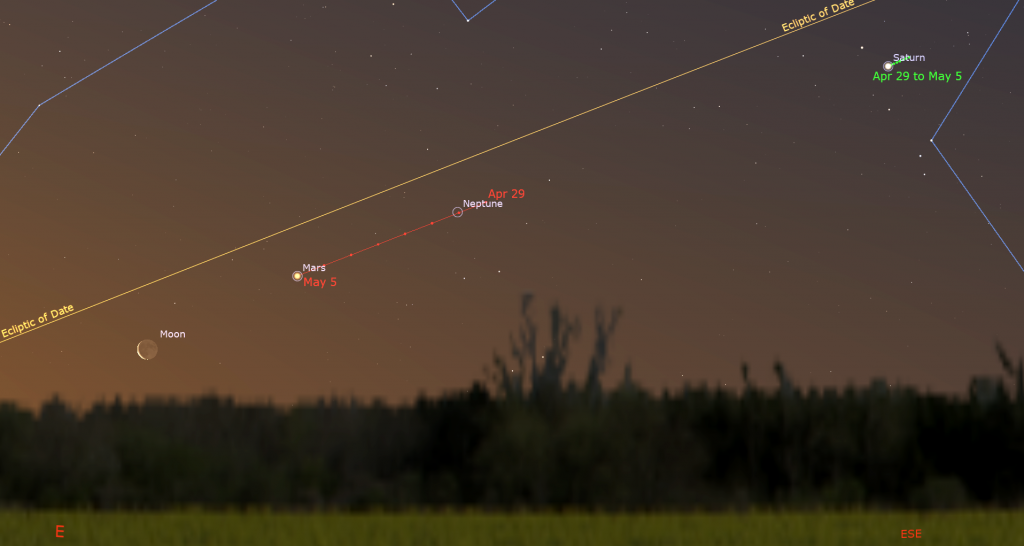
Around 4:45 am local time, the reddish planet Mars will rise to join Saturn in the eastern pre-dawn. The duo will shine with about the same intensity. Mars has been racing east along the ecliptic, increasing its angle from Saturn and closing in on Neptune. Mars and Neptune will be telescope-close from now until Tuesday. On Monday morning, Neptune will appear just 0.2 degrees from Mars. Skywatchers living at lower latitudes, where the ecliptic will be more vertical, will see their conjunction more easily – with both planets higher and in a darker sky. After Monday, Mars will widen their separation. As I mentioned above, the waning crescent moon will cruise past Neptune and then Mars – posing to their right on Saturday morning, then occulting each of them on Sunday morning for observers located around New Zealand and the Indian Ocean, respectively, and then posing off to their left next Sunday in the Americas. Remember to turn all optics away from the eastern horizon before the sun rises.
Venus is still in the eastern pre-dawn sky – but it’s too close to the sun to be observable. Venus will approach the morning sun until it reaches solar conjunction in early June. Later this year it will re-appear as the “Evening Star”.
Mercury is swinging away from the morning sun, and should start to be visible on the coming weekend. The planet will reach peak visibility while at its maximum angle of 26.4 degrees west of the sun on May 10. This pre-dawn appearance of Mercury will be so-so for mid-northern latitude observers, but the best one of the year for those in the tropics and farther south.
One More Spring Galaxy Week
During spring in the Northern Hemisphere, the obscuring stars, gas and dust of our own Milky Way galaxy vacate the night sky overhead, leaving a literal window of opportunity for observers to see distant galaxies. The completely moonless evenings from now until May 9 will provide us with the dark skies we need for seeing these faint, but majestic objects. In the Greater Toronto Area, the moonless period in March was cloudy, and then for April’s new moon everybody was distracted by the solar eclipse! If you don’t have clear skies this week, we’ll be able to see some of the galaxies in early June – or wait another year!

Astronomers consider the sky to be fully darkened when the sun is more than 18 degrees below the horizon. At mid-northern latitudes, that end of evening astronomical twilight will arrive around 10:15 pm local time this week. Head out on a clear, moonless evening, find a spot away from city lights, and look southeast. About halfway up the sky, to the upper right of the very bright star Arcturus, you’ll find the modest stars of the constellation of Coma Berenices, or “Bernice’s Hair.” Its patch of sky contains the north galactic pole and therefore far fewer stars than the rest of the sky. Coma, for short, climbs high overhead in late evening during April and in mid-evening during May – perfect for viewing distant galaxies through the least amount of Earth’s distorting atmosphere. Coma Berenices and the constellations around it – Virgo (the Maiden), Leo (the Lion), Ursa Major (The Big Bear, and the Big Dipper’s home) and Canes Venatici (the Hunting Dogs) – all host a great many galaxies. I’ll post a sky chart here that shows where they are.
If you have a good-sized telescope (say a 4” or 102 mm aperture telescope, or larger) and a dark location that is free of light pollution, put your lowest power eyepiece (or lens) in it. That’s the one with the largest number printed on it. That long focal length eyepiece will show the largest possible patch of sky through a telescope – making finding galaxies easier. (You can also see many of the following targets in larger binoculars from dark, rural sites.)
Now aim your telescope at the medium-bright star named Denebola, which marks the tail of Leo (the Lion), and focus it until Denebola is a pinpoint of light. Next, without changing the focus, aim at the spot exactly midway between Denebola and the medium-bright star Vindemiatrix in Virgo (the Maiden), which sits nearly two outstretched fist diameters to the lower left (or 17 degrees to the celestial east) of Denebola.
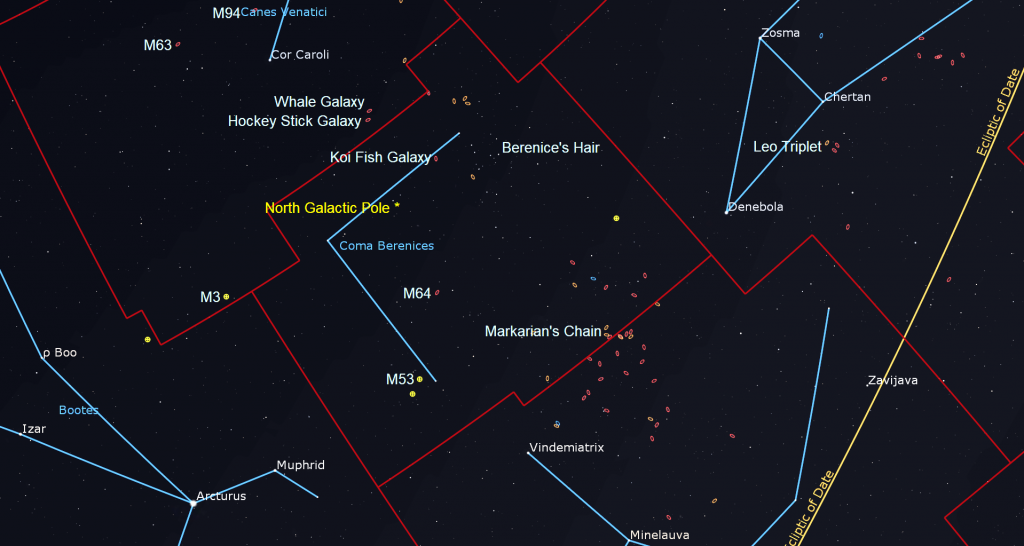
If your sky is dark and your eyes are dark-adapted, you should see a number of dim, fuzzy patches in the eyepiece. Those are members of the Virgo Cluster of Galaxies – some larger, some smaller. If you can’t be sure you’re seeing them, try lightly tapping telescope tube while you are looking. The smudges will jump around a little, allowing your brain’s wiring to see them better. Nudge the telescope around to see how many you can find. (There are dozens in that patch of sky). If you mess up the focus, or get lost, just start over.
The biggest and brightest galaxies in that neighbourhood are designated Messier 84 and Messier 86 (or M84 and M86). They are part of a curved line of galaxies known as Markarian’s Chain. In the early 1960’s, Armenian astrophysicist Benjamin E. Markarian discovered that those galaxies were travelling through the Universe as a gravitationally-bound group. Depending on your telescope type, their arc will curve down to the right or up to the right. Another prominent galaxy called M87 is located a short hop from the bend in the chain. If you recall the pictures in the news (five years ago) of an orange ring surrounding a Black Hole, M87 is the galaxy where it is located, some 60 million light-years away from us. Here’s the press release.
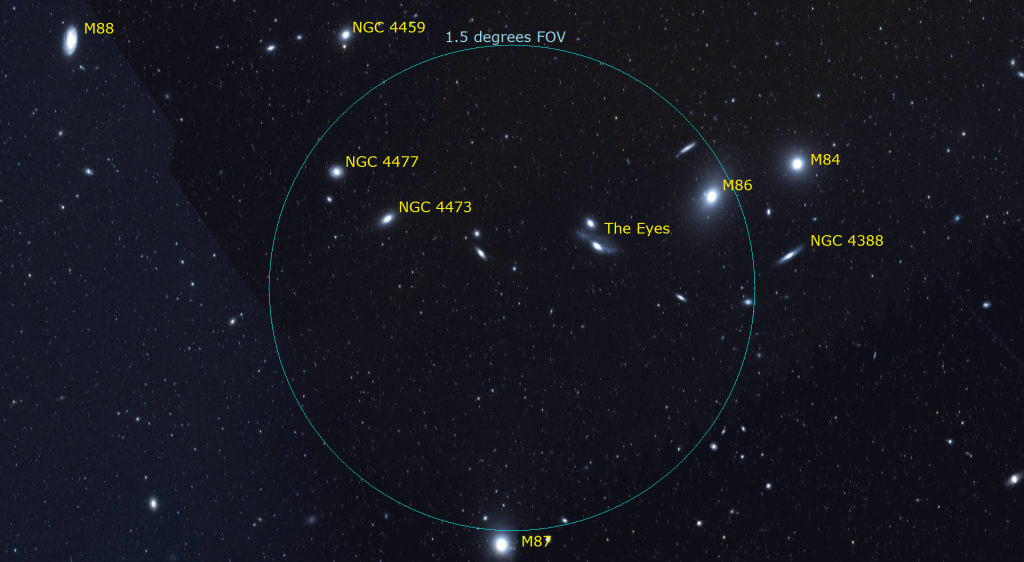
Galaxies that are oriented edge-on towards Earth appear in telescopes as short, indistinct, streaks of dim light. That’s because we’re seeing the collective light from all of that galaxy’s stars squeezed into a much smaller area of sky. Try to find the star named Gamma Comae Berenices (or γ Com or Al Dafirah). It’s close to the limit of visibility in light polluted skies, but easier to see in rural locations. That star is the uppermost of Coma Berenices’ three main stars. A collection of slightly dimmer stars gathered just to the right of Al Dafirah represents the hair of Berenice. Those are easy to see using binoculars. Other names for the cluster include Ariadne’s Hair, Thisbe’s Veil, the Cobweb Cluster, the Flying Witch, Black Bart’s Hair, and Melotte 111. In antiquity, those stars represented the tuft at the end of Leo’s tail.
From Al Dafirah, aim your telescope a slim palm’s width to the left (or 5.5 degrees to the celestial northeast). There you might glimpse the Whale Galaxy (or NGC 4631). It’s called that because, when combined with a second, smaller galaxy sitting just beside it, it resembles a whale blowing water from its spout. Another prominent galaxy called the Crowbar Galaxy, or Hockey Stick Galaxy (or NGC 4656) is positioned close enough to the whale to show up in the same field of view of your telescope. It, too, appears as a slim, fuzzy slash of light. Those two major galaxies are about 25 and 30 million light years away from us, respectively.
Returning to Al Dafirah, scan your telescope two finger widths to the lower left (or 2 degrees to the celestial east) of that star – in the direction of Coma’s brightest star Beta Com – and look for the Koi Fish Galaxy (or NGC 4559). Finally, point your telescope a few fingers widths below (or 3 degrees to the celestial southeast of) Al Dafirah. There you can look for the Needle Galaxy (or NGC 4565). This galaxy is dimmer than the other two, but it sits exactly edge-on to us – making it easier to see. It is located about 57 million light-years away from our solar system!
The Big Dipper asterism and its home constellation of Ursa Major (the Big Bear) are very high in the northern sky in late evening during early April – ideal for observing the spectacular galaxies they host in strong binoculars or backyard telescopes on moonless nights this week. Double the line connecting the dipper stars Phecda to Dubhe to arrive at the galaxy named Bode’s Nebula, otherwise known as Messier 81. It’s a magnitude 6.9 spiral galaxy oriented not quite face-on to Earth, making it appear relatively large and bright. A smaller, magnitude 8.4 galaxy named the Cigar Galaxy or Messier 82 is located half a degree to the north. That allows both galaxies to be viewed together in the eyepiece of a telescope at low magnification. Several other fainter galaxies can be found within a few degrees of Bode’s Nebula – so scan around.
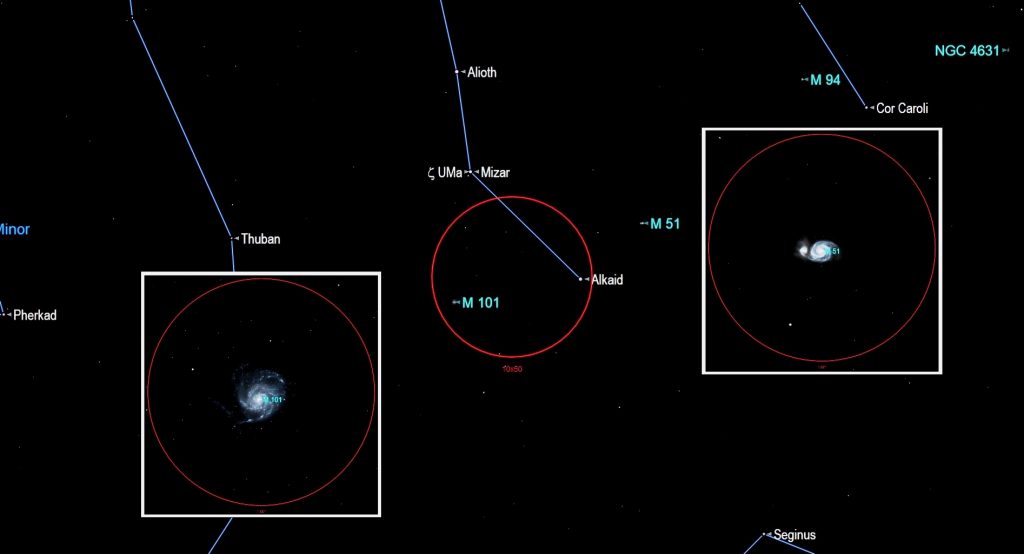
Under dark sky conditions, two impressive galaxies can be seen in binoculars and backyard telescopes by using Alkaid, the bright star that marks the tip of the Big Dipper’s handle. The Pinwheel Galaxy, or Messier 101, is a spectacular and large, face-on spiral galaxy positioned a palm’s width to the left (if facing east) or 5.5 degrees to celestial north of Alkaid, forming an equilateral triangle with Mizar, the double star at the bend of the handle. This relatively close galaxy, only 21 million light-years away, is nearly as large as the full moon in the sky. Since the galaxy’s light is spread over such a large area, its overall brightness is low, however.
Aim your binoculars or telescope several finger widths to the upper right of Alkaid to discover the iconic Whirlpool Galaxy, aka Messier 51. This spiral galaxy’s angular size is smaller, but it will look somewhat brighter in your binoculars and telescope. A secondary galaxy core designated NGC 5195 sitting alongside M51 is linked to the main spiral by a bridge of material (stars and dust).
Let me know how you make out with your galaxy search!
Galaxy Types
Let’s talk about how we use the various shapes the galaxies have to classify them and understand how they came to be.
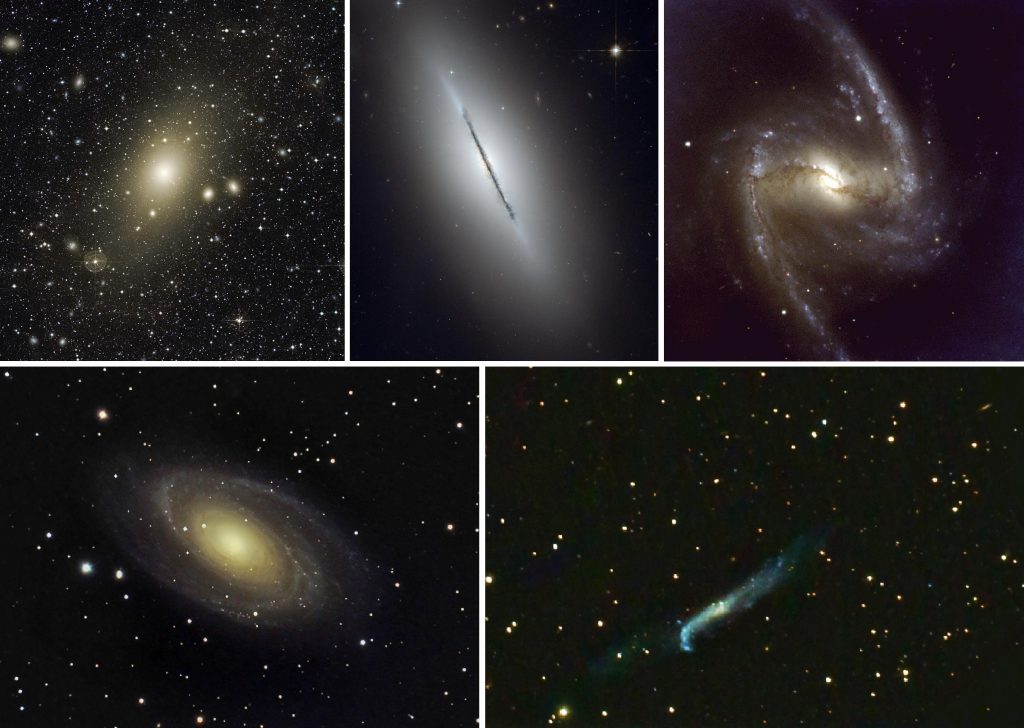
During early 1920’s at Palomar Observatory in California, astronomer Edwin Hubble was using the recently discovered Cepheid variable star period-luminosity formula to estimate the dimensions of our Milky Way galaxy. Cepheid variable stars vary in brightness with a period of time that is in direct proportion to their true (or intrinsic) brightness. By comparing how bright the star appears with how bright it actually would be if you were a specified distance from it, astronomers could estimate how far away that star is and build up a framework for the shape and size of our galaxy.
At the time, before large telescopes were available, astronomers did not know that many of the fuzzy patches they were observing in the sky were objects outside of our galaxy; that they were completely other galaxies. They just called them “nebulas”. When Hubble found Cepheids in some of those “nebulas”, such as the one we now call the Andromeda Galaxy (Messier 31), and calculated their distances, he was astonished. Knowing how large our Milky Way galaxy is, he realized that those nebulas must be other galaxies unto themselves!
Starting in 1926, Hubble began to classify galaxies into four styles, based upon the way they look in photographs and through a telescope. He used the terms elliptical (E), lenticular (SO), spiral (S), and irregular (I). Elliptical galaxies are rather dull-looking clumps of stars ranging from round (E0) to highly stretched (E7). But they are now known to be enormous – the product of multiple galaxies merging together and losing their original structures. Each elliptical seems to host a supergiant black hole in the centre. Our Milky Way galaxy and the Andromeda Galaxy will merge in several billion years, probably producing a new elliptical galaxy.

Spiral galaxies have a central core with arms wrapping around it in a flattened disk. The arms can be large or small, and loosely or tightly wound. There can be many arms, or as few as two. The central core can be round or elongated. Needing a way to manage all these differences, Hubble developed the Tuning Fork scheme, where one tine held the round-core spirals (the SA type), sorted by the tightness of their arms. The other tine did the same for galaxies with elongated, or barred, cores (the SO type). He added the letters “a” to “c” to indicate how tightly wound they were.
The ellipticals formed the handle of the fork. Where the fork split, Hubble placed the lenticular galaxies. Those have a central core but no apparent spiral arms, possibly because they have “relaxed” their arms with age – more like a Frisbee than an octopus.
Starting in 1959 French astronomer Gérard de Vaucouleurs and American astronomer Allan Sandage refined Hubble’s system. They added a middle branch for intermediate spirals (SAB type), and lengthened the tines with “d” for very loosely wound, plus “m” for a single arm (i.e., barely a spiral at all). At the far end he placed the leftovers, irregular galaxies. Those are probably gravitationally distorted versions of normal galaxy types.
We classify galaxies based on how they look from Earth, so there’s ambiguity, especially if they are seen edge-on. We can use spectroscopy and images taken at other wavelengths of light to peer inside galaxies and determine their form – even the edge-on ones. The galaxy’s classification codes are often displayed in programs and apps like Stellarium, SkySafari, and Starwalk 2. I’ll post here a picture of the scheme along with photos of some examples of the different types.
Tips for Galaxy Viewing
Here are some tips for finding and viewing galaxies. Start off with a good sky chart or app that shows the prominent stars around your quarry. The book 110 Things to See With a Telescope I co-authored with John A. Read has easy charts for many dozens of them.
A dark, clear, and transparent sky is the key for success with galaxies! Choose cloud-free, moonless nights (from third quarter to new moon phase each lunar month) and a viewing site away from artificial lights and the city light domes that wash out the night sky. Humid air can dim faint objects, too – as can forest fire smoke and dust. To maximize your eyes’ ability to see faint galaxies, avoiding looking at white light sources for at least half an hour in advance, including car headlights, flashlights, and phone and tablet screens. Dim, red light won’t spoil your dark adaptation. Cover device screens with red film. If you plan to make notes at the eyepiece, use a red headlamp or flashlight. I even cover one white notebook page with dark paper while I write on the opposite page, to reduce the glare. I recently purchased a pair of the red plastic goggles laser technicians use. They work great for preserving your dark adaptation between looks in the telescope.
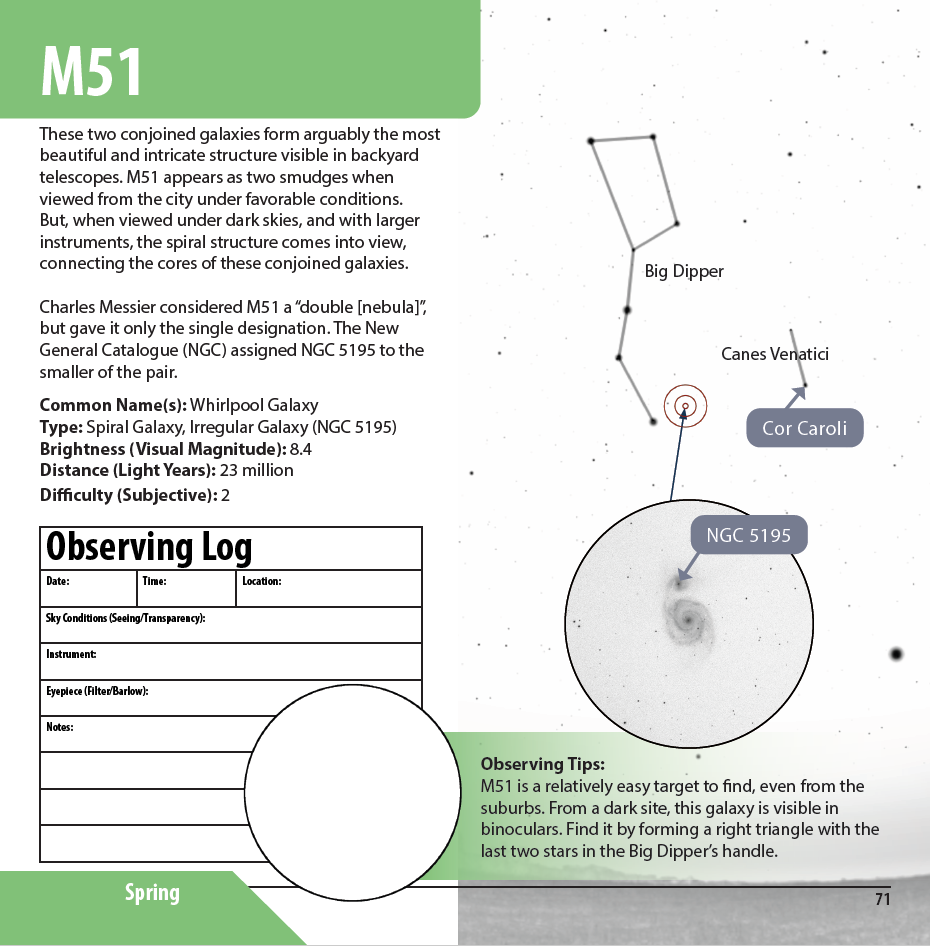
You can also maximize your eyes’ sensitivity by learning to use averted vision when looking through a telescope. The technique involves drawing your attention towards the edge of the eyepiece’s field of view and let your peripheral vision pick up the faint galaxy in the middle. It works because the most sensitive light receptors in your eyes aren’t the central ones. For the best visual acuity, avoid consuming alcohol before observing, try to be comfortably seated, and breathe deeply to oxygenate your eyes.
If you can’t see the galaxy at first, tap the telescope while viewing through it. Faint objects that are in motion will draw your attention better – again by using different eye receptors and brain pathways. If objects seem dimmer than expected, check that you don’t have dew or frost on your lenses and/or mirrors. At home, a hair dryer set to cool and waved across the optics from 30 cm away can clean things up. A 12v blower/fan for camping can work, too. Strapping a chemical hand warmer around the underside of your telescope can help, in a pinch.
For telescope users, always start searching for galaxies with your lowest power, longest focal length eyepiece. I like a combination that gives me a 1.5° field of view, or three times the moon’s diameter. Once you have the target, note your initial impressions, and then swap in stronger eyepieces to enlarge it. Go easy on zooming in, though. Remember that many galaxies are quite large – a substantial fraction of the moon’s diameter – and you may notice more if they aren’t too spread out under high power!

Faint objects are tough to see in small aperture finder scopes. For searching, I recommend adding to or replacing the magnifying finder scope with a Telrad Reflex Sight or another non-magnifying (1X) finder that projects dim red bull’s-eye rings onto a window that you look through while pointing the telescope. Those are terrific because you can always see the brighter stars around the galaxy. Just place those telrad rings on or between nearby bright stars. By the way, it’s a good idea to use stars near your galaxy to focus the telescope before you look for the galaxy itself.

If you are using a star atlas or an app to find your galaxy, remember that the view in the eyepiece will probably be flipped and/or mirror-imaged. Newtonian reflector telescopes (the big cannon-type) rotate the binoculars view by 180 degrees. With them, just turn the book upside down to match the eyepiece view! Refractor telescopes and Schmidt-Cassegrain telescopes (SCT) that use a right-angle mirror to hold the eyepiece will mirror-image the regular scene. It’s helpful to know the expected field of view delivered by your searching eyepiece, too. Some people like to make FOV circles to overlay on paper atlas pages. The better astronomy apps will let you display FOV circles and to flip the display to match your telescope.
If the galaxy you are chasing is not conveniently located near any reference stars, you can start at the best star available and then “star-hop” following recognizable star patterns. Place distinct asterisms at the edge of the FOV opposite to your target. Later, note which stars you hopped to in your observing log. Remember to account for the flipped / mirror-imaged directions.
A Last point – astronomical filters will not help you see or photograph galaxies. Galaxies emit starlight across a broad range of wavelengths, and you want as much of that as you can get!
Eta-Aquariids Meteor Shower
The annual Eta-Aquariids Meteor Shower is produced when Earth’s orbit carries us through a cloud of particles left behind by repeated passages of Halley’s Comet. The shower, which runs from April 19 to May 28, will peak in intensity on next Sunday evening, May 5 in the Americas – with no moonlight to spoil the show! While meteors should be visible on Sunday after dusk, more should appear once the shower’s radiant point in Aquarius (the Water-Bearer) rises above the southeastern horizon around 3 am local time next Monday. A few dozen meteors per hour are typical during the peak – including some fireball meteors. Its southerly radiant makes the Eta-Aquariids shower better for observers located closer to the tropics.

Public Astronomy-Themed Events
Every Monday evening, York University’s Allan I. Carswell Observatory runs an online star party – broadcasting views from four telescopes/cameras, answering viewer questions, and taking requests! Details are here. They host in-person viewing on the first clear Wednesday night each month. Other Wednesdays they stream views online via the observatory YouTube channel. Details are here.
On Wednesday evening, May 1 at 7:30 pm EDT, the RASC Toronto Centre will host their free, public, in-person monthly Recreational Astronomy Night Meeting in the Loft at the Ontario Science Centre. The meeting will also be live streamed at https://www.youtube.com/rasctoronto/live. Talks will focus on the recent solar eclipse. Details are here.
On Saturday, May 4 from 10 am to noon, you can try out Solar Observing at the Ontario Science Centre! If it’s sunny, members of the RASC Toronto Centre will be setting up outside on the Teluscape in front of the main doors. They’ll have an array of special equipment designed to view the Sun safely. This is free to the public, but parking and admission fees inside the Science Centre will still apply. Check the RASC Toronto Centre website or their Facebook page for the Go or No-Go notification.
Spend some time in the other dome at the David Dunlap Observatory! On Saturday, May 25, you can join me in my Starlab Digital Planetarium for an interactive journey through the Universe at DDO. We’ll tour the night sky and see close-up views of galaxies, nebulas, and star clusters, view our Solar System’s planets and alien exo-planets, land on the moon, Mars – or the Sun, travel home to Earth from the edge of the Universe, hear indigenous starlore, and watch immersive fulldome movies! Ask me your burning questions, and see the answers in a planetarium setting – or sit back and soak it all in. Please note that all guests will sit on a clean floor. A registered adult must accompany all registered participants under the age of 16. We run sessions geared to junior astronomers in the morning and family sessions in the afternoon. Registration is required. More information and the registration links are here.
Keep your eyes on the skies! I love getting questions and requests. Send me some!